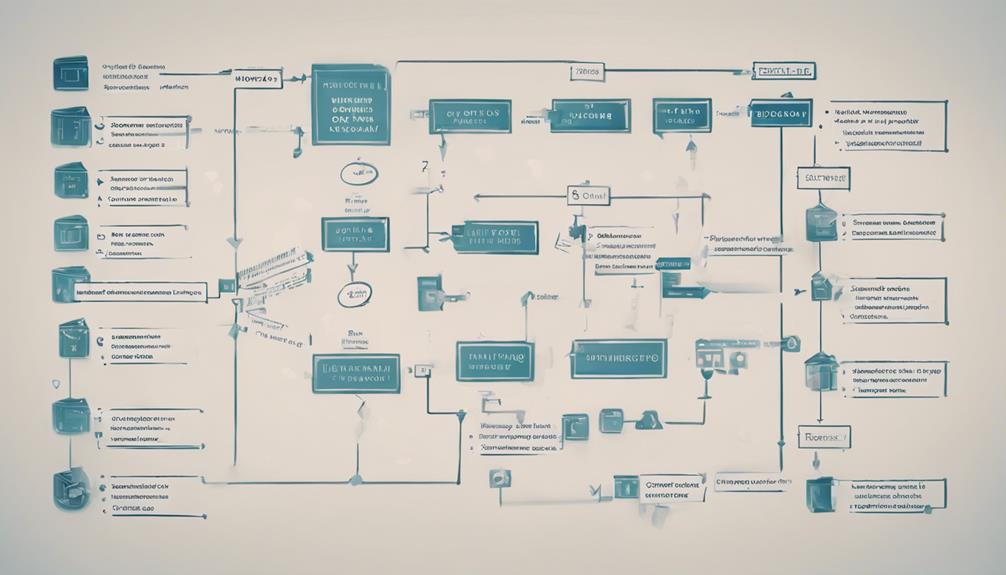Imagine a ship navigating through turbulent waters; just as a skilled captain steers through challenges, handling customer complaints in order processing services requires finesse and precision. As you encounter dissatisfied customers seeking resolution, your ability to provide efficient and satisfactory solutions becomes paramount. But how can you navigate these waters effectively, ensuring smooth sailing for both customer satisfaction and operational efficiency? Stay tuned as we explore practical strategies and best practices for mastering the art of handling customer complaints in order processing services.
Establish Complaint Process
To effectively handle customer complaints in order processing services, establish a clear and efficient complaint process that prioritizes swift resolution and customer satisfaction. Begin by creating a designated channel, whether it’s an email address, a phone line, or an online form, where customers can easily submit their concerns. Ensure that this process is well-documented and communicated to all staff members involved in handling complaints.
Regularly review customer feedback to identify recurring issues and areas for process improvement. By analyzing common complaints, you can proactively address underlying issues and prevent future occurrences. Implement changes based on this feedback to enhance the overall customer experience and minimize the chances of similar complaints arising in the future.
Train Staff
Enhance customer service quality by providing comprehensive training to your staff on effective complaint handling techniques and procedures. Engage your team in role-playing scenarios to simulate real-life customer complaints, allowing them to practice resolving issues in a supportive environment. Team building exercises can foster collaboration and empathy among staff, leading to a more cohesive approach to addressing customer concerns.
Consider organizing communication workshops to enhance active listening skills and teach employees how to communicate clearly and empathetically with customers. These sessions can also focus on de-escalation techniques to handle challenging situations with professionalism and tact. Additionally, feedback sessions are crucial in improving staff performance. Provide constructive feedback on how employees handle complaints, praising effective strategies and offering guidance on areas that need improvement.
Receive Complaints
When customers reach out with complaints, it is crucial to acknowledge their concerns promptly. Listen actively to what they have to say, demonstrating empathy and understanding. Offer solutions promptly to address their issues and ensure their satisfaction.
Acknowledge Customer Concerns
Upon receiving a customer complaint, promptly acknowledge their concerns to demonstrate attentiveness and a commitment to resolving the issue efficiently. When addressing customer complaints, it is crucial to handle them with care and understanding. Here are some key steps to acknowledge customer concerns effectively:
- Apologize Sincerely: Begin by expressing a genuine apology for any inconvenience caused to the customer.
- Offer Compensation: Consider providing appropriate compensation as a gesture of goodwill and to make up for any inconvenience experienced.
- Listen Attentively: Pay close attention to the customer’s complaint to fully understand the issue at hand.
- Show Empathy: Demonstrate empathy towards the customer’s situation to convey understanding and concern.
Listen Actively to Complaints
To effectively address customer complaints, actively listen to their concerns to demonstrate attentiveness and a genuine interest in resolving issues promptly. Empathy training plays a crucial role in this process. When customers feel heard and understood, it can significantly improve their overall experience. Effective communication is key during this stage. Ensure that you are fully present, providing your undivided attention to the customer. Acknowledge their feelings and frustrations while maintaining a professional and empathetic tone.
Empathy training can help you relate to customers on a deeper level, showing them that you genuinely care about their concerns. Through active listening, you can uncover the root cause of the problem and work towards finding a suitable solution. Remember, effective communication involves not only hearing what the customer says but also understanding the underlying emotions driving their complaints. By mastering the art of listening attentively and with empathy, you can build trust and rapport with customers, paving the way for smoother conflict resolution.
Offer Prompt Solutions
Ensure that you promptly address customer complaints to provide timely solutions and demonstrate your commitment to resolving issues efficiently. When handling complaints in order processing services, offering prompt solutions is crucial for customer satisfaction and effective service recovery. Here are five key ways to ensure you are offering prompt solutions:
- Acknowledge the issue: Quickly acknowledge the customer’s complaint to show that you are actively listening and ready to assist.
- Investigate promptly: Take immediate steps to investigate the problem to understand the root cause and find a solution swiftly.
- Communicate clearly: Keep the customer informed about the progress of resolving their issue to maintain transparency and trust.
- Provide alternatives: Offer alternative solutions or compensation options to show flexibility and a willingness to make things right.
Investigate Issues
Understanding the root causes behind customer complaints is crucial in the investigation process within order processing services. When conducting root cause analysis, it’s essential to delve deep into the issues to identify the underlying reasons for customer dissatisfaction. This involves looking beyond the surface-level problems to pinpoint where things went wrong in the order processing chain.
To effectively investigate issues, start by collecting all relevant data related to the customer’s complaint. Analyze each step of the order processing journey to identify potential areas of improvement. Once the root causes have been identified, the next step is implementing corrective actions. This could involve revising internal processes, providing additional training to staff, or updating technology systems to prevent similar issues from occurring in the future.
Resolve Complaints
When handling customer complaints in order processing services, it’s crucial to address specific issues promptly. Providing timely solutions shows customers that their concerns are taken seriously. Improving communication channels can help prevent future complaints and enhance overall customer satisfaction.
Addressing Specific Issues
Address each specific issue promptly and effectively to ensure customer satisfaction with the resolution process.
- Listen Carefully: Give the customer your full attention to understand the problem accurately.
- Identify Root Causes: Get to the bottom of the issue to prevent it from happening again.
- Apologize Sincerely: Express genuine regret for any inconvenience caused to the customer.
- Offer Solutions: Provide viable options to resolve the problem and let the customer choose.
Providing Timely Solutions
Listening attentively to customer concerns plays a crucial role in swiftly resolving complaints in order processing services. When customers encounter issues, it’s vital to provide timely solutions to ensure their satisfaction. Effective resolutions not only address the specific problem but also demonstrate your commitment to customer service.
To achieve customer satisfaction, respond promptly to complaints. Acknowledge the issue, apologize for any inconvenience caused, and work towards a solution. Keep the customer informed of the steps being taken to resolve the issue, providing transparency and reassurance throughout the process.
When offering solutions, focus on resolving the problem efficiently while prioritizing the customer’s needs. Tailor your approach to each situation, considering the customer’s perspective and offering alternatives if needed. By actively listening to customers and promptly addressing their concerns with effective solutions, you can enhance their experience and build trust in your order processing services.
Improving Communication Channels
To enhance the resolution of complaints in order processing services, it is imperative to establish clear and efficient communication channels for customers to voice their concerns. Here are some strategies to improve communication channels and effectively resolve customer complaints:
- Encourage Customer Feedback: Actively seek feedback from customers at various touchpoints to understand their experiences and identify areas for improvement.
- Implement Multi-Channel Communication: Offer various communication channels such as phone, email, chat support, and social media to accommodate diverse customer preferences.
- Provide Real-Time Updates: Keep customers informed about their orders through automated updates or notifications to reduce uncertainty and anxiety.
- Train Customer Service Representatives: Equip your staff with effective communication skills and problem-solving techniques to address complaints professionally and empathetically.
Follow up With Customers
After resolving a customer complaint, it is crucial to promptly follow up to ensure their satisfaction and maintain a positive relationship. Following up shows that you value the customer’s feedback and are committed to resolving any issues they may have. It also provides an opportunity to gather valuable insights through feedback collection, helping you improve your order processing services.
When following up with customers, express gratitude for bringing the issue to your attention and reiterate your commitment to their satisfaction. Ask if the resolution met their expectations and if there is anything else you can do to enhance their experience. This proactive approach demonstrates your dedication to customer satisfaction and can turn a negative experience into a positive one.
In addition to addressing the specific complaint, use follow-up interactions to request feedback on the overall customer experience. Encourage customers to share their thoughts on how you can enhance your services further. By actively seeking feedback and acting upon it, you show customers that their opinions are valued and that you are continuously striving to improve.
Monitor Complaint Trends
When addressing customer complaints, it’s important to monitor complaint trends to identify recurring issues and improve overall service quality. By analyzing data, you can gain valuable insights into customer experiences and pinpoint areas for improvement. Here are five key steps to effectively monitor complaint trends:
- Track Complaint Types: Categorize complaints to understand the most common issues customers face.
- Identify Root Causes: Dive deep into the reasons behind recurring complaints to address core issues.
- Monitor Frequency: Keep a close eye on how often certain complaints arise to prioritize improvements.
- Seek Customer Feedback: Actively gather input from customers to validate trends and gather new insights.
Frequently Asked Questions
How Can I Escalate My Complaint if Not Resolved?
So, you’re not satisfied with the resolution? No problem! To escalate your complaint, contact a supervisor or manager. They’ll guide you through the escalation process and provide additional resolution options to address your concerns.
Can I Request Compensation for the Inconvenience?
Yes, you can request compensation for the inconvenience. Ensure you clearly outline the issue, express the impact it had, and suggest a fair resolution. By addressing customer satisfaction through compensation, you can reach a satisfactory resolution.
Will My Complaint Be Kept Confidential?
Your complaint will be kept confidential. We assure privacy protection and maintain confidentiality. Feel at ease knowing that your concerns are handled discreetly. Your trust is essential, and we prioritize safeguarding your information.
What Measures Are in Place to Prevent Future Issues?
To prevent future issues, we continually update training programs for staff and implement process improvements. These measures are in place to enhance efficiency and accuracy, ensuring a smoother experience for you in the future.
Is There a Feedback Mechanism for Improving Services?
You’ve got a fantastic feedback mechanism in place for service improvement. It’s all about enhancing customer satisfaction. Keep up the good work by listening to feedback and making those valuable changes.



